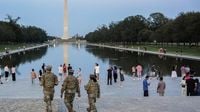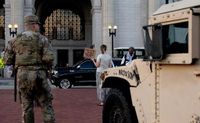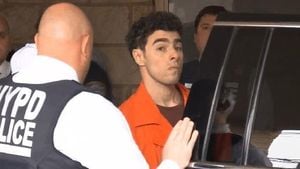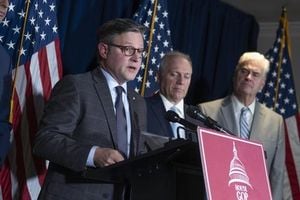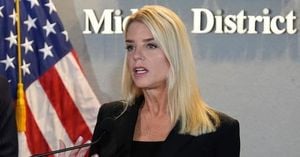On a sweltering August afternoon in 2025, the streets of Washington, D.C. took on a tense new atmosphere. Near Union Station, a lone demonstrator stood face-to-face with a National Guard member, the scene emblematic of a city at the heart of a national controversy. Over the weekend of August 16-17, governors from three Republican-led states—West Virginia, South Carolina, and Ohio—announced they would send hundreds of National Guard troops to bolster President Donald Trump’s already robust deployment in the nation’s capital, according to Bloomberg and TIME.
West Virginia Governor Patrick Morrisey led the charge, committing between 300 and 400 Guard troops. South Carolina’s Governor Henry McMaster pledged another 200, while Ohio’s Governor Mike DeWine said 150 Guard members would soon arrive. These reinforcements nearly doubled the number of National Guard personnel in D.C., joining the 800-strong deployment already ordered by President Trump the previous week. As McMaster put it, the troops were being sent “to support President Trump in his mission to restore law and order to our nation’s capital,” but he added that they would return home if an emergency struck South Carolina. Morrisey, for his part, emphasized that the deployment came “at the request” of Trump and as a demonstration of “regional cooperation.” His office elaborated, “WVNG involvement will include providing mission-essential equipment, specialized training, and approximately 300-400 skilled personnel as directed.”
This escalation marked a significant turning point in Trump’s federal takeover of policing in Washington, D.C.—a move that has sparked both protests and fierce criticism from local officials and civil liberties advocates. The president invoked emergency powers in early August, claiming that the city was beset by “bloodshed, bedlam and squalor.” He argued that such drastic steps were necessary, not only in D.C. but potentially in other major cities such as New York City, Baltimore, and Oakland, which he described as “so far gone.” “This will go further. We’re starting very strongly with D.C.,” Trump declared, according to TIME.
Yet, these claims have been sharply disputed by experts and city leaders. D.C. Mayor Muriel Bowser, who has been at the forefront of local opposition, took to social media on August 16 to voice her dismay: “American soldiers and airmen policing American citizens on American soil is #UnAmerican.” Bowser’s criticism reflects a broader unease among D.C. residents and officials who see the federal intervention as an overreach—especially given that, according to city data, crime in the capital has actually decreased over the last two years, following a spike in 2023.
Despite the sweeping federal action, the day-to-day command of the Metropolitan Police Department (MPD) remains under Chief Pamela Smith. This arrangement persists after a failed attempt by the Trump administration to install the head of the Drug Enforcement Administration (DEA) as an “emergency police commissioner.” Nonetheless, Bowser and other city leaders are now required to cooperate with the president’s executive order declaring a state of emergency in the district—a legal maneuver that has forced an uneasy partnership between local and federal authorities.
The deployment is not limited to the National Guard. Federal officers from a range of agencies—including the U.S. Park Police, Immigration and Customs Enforcement (ICE), the FBI, the Bureau of Alcohol, Tobacco and Firearms, and the U.S. Marshals Service—have been assigned to night patrols throughout D.C. Checkpoints have sprung up around the city, and in the first week of the federal takeover, law enforcement arrested nearly 200 people. Notably, 75 of those arrests were made by ICE, a sign that Trump’s aggressive immigration tactics, revived since his return to office in January, are being woven into the broader federal response.
The rapid mobilization of National Guard troops from out-of-state has stoked debate about the proper role of the military in domestic law enforcement. Critics argue that the use of soldiers and federal agents to police American citizens sets a dangerous precedent, undermining local autonomy and civil liberties. As TIME reports, some federal agents assigned to the capital are now performing duties far outside their usual scope, raising concerns about their preparedness and the wisdom of diverting them from their original missions.
For supporters of the president’s actions, however, the influx of troops and federal officers is a necessary step to reassert control and restore safety. Governor McMaster’s statement made clear that his administration views the deployment as a patriotic duty, aligned with the president’s vision of law and order. Similarly, West Virginia’s Governor Morrisey highlighted the importance of “regional cooperation,” framing the move as a collective effort to stabilize the capital at a time of perceived crisis.
Underneath the political rhetoric, the numbers tell a more complex story. While Trump’s justification for the takeover hinges on claims of spiraling crime, the data cited by Mayor Bowser and city officials points to a downward trend in violent incidents since 2023. This discrepancy has fueled accusations that the president’s response is more about consolidating executive power than addressing actual security threats. The failed attempt to place a DEA head in charge of the MPD further underscores the tensions between federal ambitions and local governance.
Meanwhile, the city itself has become a patchwork of jurisdictions and authorities, with National Guard troops, federal agents, and local police all sharing the streets. The nearly 200 arrests in the first week—75 of them by ICE—reflect a law enforcement strategy that blends crime control with immigration enforcement, a hallmark of Trump’s broader policy agenda.
The situation in Washington, D.C. is being watched closely by leaders in other major cities, particularly those named by Trump as future targets for federal intervention. The prospect of similar takeovers in New York, Baltimore, and Oakland has already provoked alarm among civil rights groups and urban officials, who worry about the implications for democracy and local self-determination. At the same time, some voters in states sending troops to D.C. see the move as a justified response to urban unrest and a show of solidarity with the president’s law-and-order platform.
As the capital’s summer draws to a close, the city remains under the shadow of federal authority, its residents caught between competing visions of safety, freedom, and the proper limits of executive power. The coming weeks will test not only the effectiveness of the federal deployment but also the resilience of local institutions and the balance of power in American democracy.
